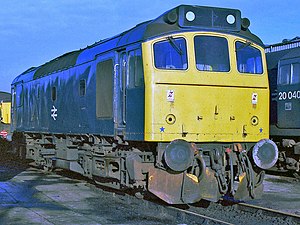British Rail Class 25

Class 25 locomotive stands on Springs Branch Traction Maintenance Depot at Wigan
|
|||||||||||||||||||||||||||||||||||||||
|
|||||||||||||||||||||||||||||||||||||||
|
|||||||||||||||||||||||||||||||||||||||
|
|||||||||||||||||||||||||||||||||||||||
|
|||||||||||||||||||||||||||||||||||||||
| Type and origin | |
|---|---|
| Power type | Diesel-electric |
| Builder | British Railways’ Crewe Works, Darlington Works and Derby Works; Beyer, Peacock & Co. |
| Build date | 1961–1967 |
| Total produced | 327 |
| Specifications | |
|---|---|
| Configuration | Bo-Bo |
| UIC class | Bo'Bo' |
| Gauge | 4 ft 8 1⁄2 in (1,435 mm) standard gauge |
| Wheel diameter | 3 ft 9 in (1.143 m) |
| Minimum curve | 4.5 chains (91 m) |
| Wheelbase | 36 ft 6 in (11.125 m) |
| Length | 50 ft 6 in (15.392 m) |
| Width | 9 ft 1 in (2.769 m) |
| Height | 12 ft 8 in (3.861 m) |
| Loco weight | 73 long tons (74.2 t; 81.8 short tons) |
| Fuel capacity | 500 imp gal (2,300 l; 600 US gal) |
| Prime mover | Sulzer 6LDA28-B |
| Generator | BTH generator, type RTB 15656 |
| Traction motors | D5151-D5175, four BTH traction motors others: four AEI 253 AY traction motors DC |
| Transmission | Diesel electric |
| MU working | ★ Blue Star |
| Train heating | Steam (when present) |
| Train brakes | Vacuum |
| Performance figures | |
|---|---|
| Maximum speed | 75 mph (121 km/h) |
| Power output | Engine: 1,250 hp (932 kW) @750 rpm |
| Tractive effort | Maximum: 39,000 lbf (170 kN) to 45,000 lbf (200 kN) |
| Loco brakeforce | 38 long tons-force (380 kN) |
| Career | |
|---|---|
| Operators | British Railways |
| Numbers | D5151–D5299, D7500–D7677; later 25001–25327 |
| Nicknames | Rats |
| Axle load class | Route availability 4 |
The British Rail Class 25 diesel locomotives were also known as Sulzer Type 2. In total, 327 locomotives of this type were built between 1961 and 1967.
The Class 24 locomotives were the precursor of the Class 25 design but after the delivery of their first few units it became apparent that the speed ceiling of 75 mph (121 km/h) was unduly restrictive and the provision of additional power would be advantageous. In the course of normal development the power output of the Sulzer six-cylinder engine had been increased by 90 hp (67 kW) to give a continuous traction output of 1,250 bhp (930 kW) at 750 rpm by the introduction of charge air cooling and the first locomotives to use this became known as Class 25 locomotives.
The Class 25 locos were primarily designed for freight work, but a significant number were fitted with boilers for heating passenger trains. Throughout the 1970s they could be found at work across the whole of the British Rail network although the Eastern and Southern Regions never had an allocation. Though regular performers into the early 1980s on Crewe–Cardiff passenger trains, they are best known in that respect for their use on the summer Saturday trains to Aberystwyth, a task they relinquished in 1984. The final Class 25 locomotive was withdrawn from service in March 1987.
The first 25 locos became known as Class 25/0 and were built at the BR Darlington works using the newer 1,250 hp (930 kW) "B" engine, modified generator assembly and traction motors. This increase in power was obtained from an air/water free flow intercooler fitted between a higher capacity pressure charger and inlet manifold, included within the normal cooling circuit to maintain simplicity. The cylinder head was also modified and strengthened.
The BTH generator, type RTB 15656, was rated as 817.5 kW (1,096.3 hp), 750/545 V, 1090/1500 A at 750 rpm, only slightly different from that used in the earlier Class 24s. (Note all Class 25 locomotives used a generator designated as BTH RTB 15656 but its rating and characteristics changed over time). The generator supplied four BTH 137BX traction motors connected in parallel and rated 245 hp (183 kW), 545 V, 375 A at 560 rpm with a gear ratio of 18:79 (to give a 90 mph (140 km/h) maximum speed). Maximum tractive effort was 39,000 lbf (170 kN) and continuous tractive effort was 20,800 lbf (93,000 N) at 17.1 mph (27.5 km/h), the latter standard for all Class 25s. Power at rail was 949 hp (708 kW), now available between 9.3 and 77.6 mph (124.9 km/h). For the first fifteen locomotives fuel capacity was 520 imp gal (2,400 l; 620 US gal) (design type 25 AV) and the final ten had larger 620-imperial-gallon (2,800 l; 740 US gal) fuel tanks installed (design type 25 BV).
...
Wikipedia
